1、实验任务1
源代码
1 #include <stdio.h> 2 #include <stdlib.h> 3 #include <time.h> 4 #include <windows.h> 5 #define N 80 6 void print_text(int line, int col, char text[]); // 函数声明 7 void print_spaces(int n); // 函数声明 8 void print_blank_lines(int n); // 函数声明 9 int main() { 10 int line, col, i; 11 char text[N] = "hi, November~"; 12 13 srand(time(0)); // 以当前系统时间作为随机种子 14 15 for(i = 1; i <= 10; ++i) { 16 line = rand() % 25; 17 col = rand() % 80; 18 print_text(line, col, text); 19 Sleep(1000); // 暂停1000ms 20 } 21 return 0; 22 } 23 // 打印n个空格 24 void print_spaces(int n) { 25 int i; 26 27 for(i = 1; i <= n; ++i) 28 printf(" "); 29 } 30 31 // 打印n行空白行 32 void print_blank_lines(int n) { 33 int i; 34 35 for(i = 1; i <= n; ++i) 36 printf("\n"); 37 } 38 39 // 在第line行第col列打印一段文本 40 void print_text(int line, int col, char text[]) { 41 print_blank_lines(line-1); // 打印(line-1)行空行 42 print_spaces(col-1); // 打印(col-1)列空格 43 printf("%s", text); // 在第line行、col列输出text中字符串 44 }
运行结果截图
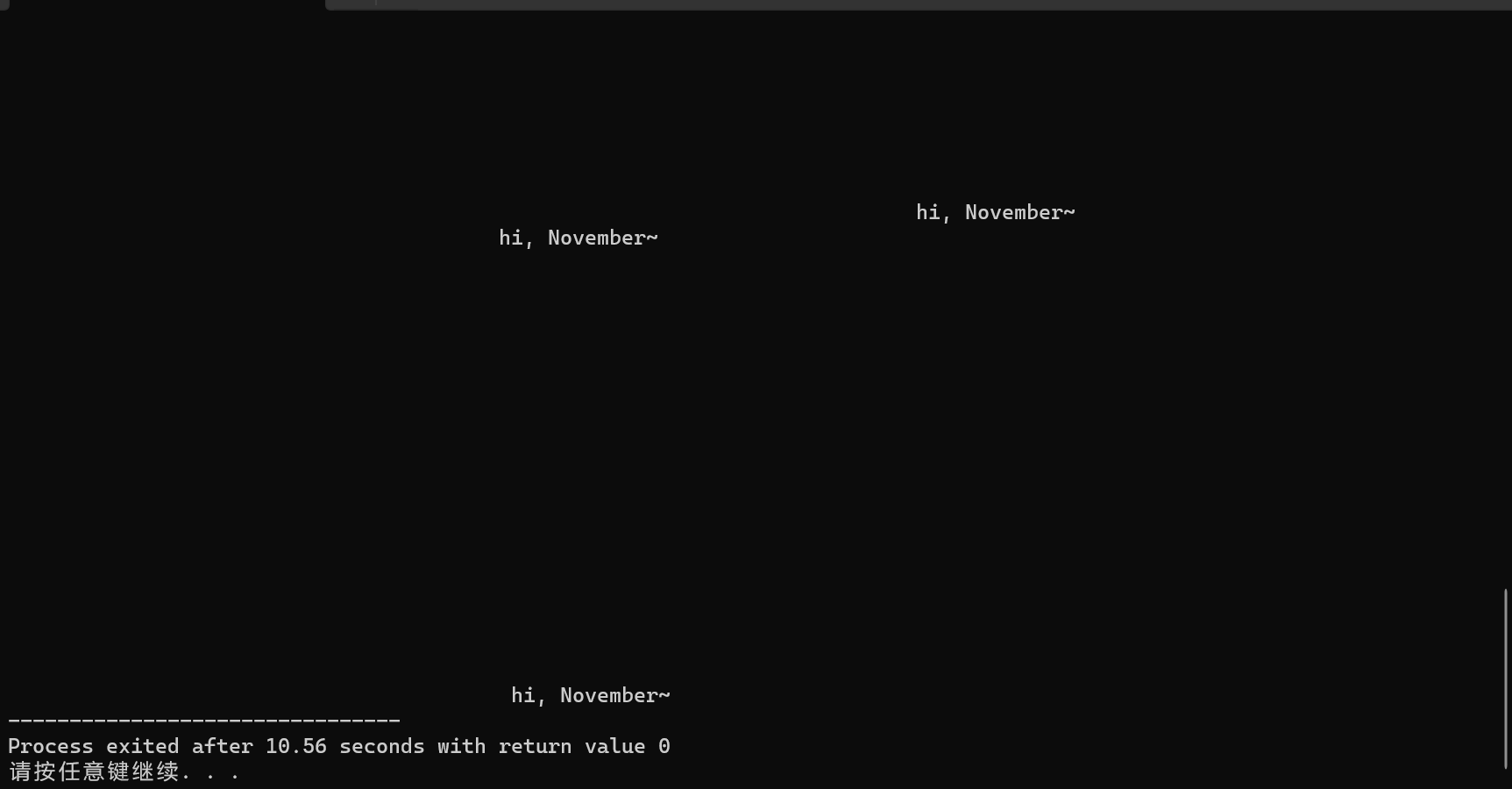
实验结论:字符串的随机出现
2、实验任务2
源代码
1 // 利用局部static变量的特性,计算阶乘 2 #include <stdio.h> 3 long long fac(int n); // 函数声明 4 int main() { 5 int i, n; 6 printf("Enter n: "); 7 scanf("%d", &n); 8 for (i = 1; i <= n; ++i) 9 printf("%d! = %lld\n", i, fac(i)); 10 return 0; 11 } 12 // 函数定义 13 long long fac(int n) { 14 static long long p = 1; 15 printf("p=%lld\n",p); 16 p = p * n; 17 return p; 18 }
运行结果截图
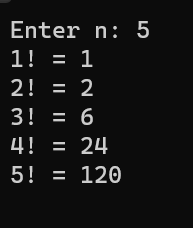

源代码
1 // 练习:局部static变量特性 2 #include <stdio.h> 3 int func(int, int); // 函数声明 4 int main() { 5 int k = 4, m = 1, p1, p2; 6 7 p1 = func(k, m); // 函数调用 8 p2 = func(k, m); // 函数调用 9 printf("%d, %d\n", p1, p2); 10 11 return 0; 12 } 13 // 函数定义 14 int func(int a, int b) { 15 static int m = 0, i = 2; 16 printf("%d%d\n",m,i); 17 i += m + 1; 18 m = i + a + b; 19 return m; 20 }
运行结果截图

局部static变量特性:static变量可以使变量的访问范围控制在函数内,并且保存变量值至下一次调用,所占内存在程序运行结束时释放。即下一次调用时变量初始化值为上一次调用的最终值。
3、实验任务3
源代码
1 #include <stdio.h> 2 long long func(int n); // 函数声明 3 int main() { 4 int n; 5 long long f; 6 while (scanf("%d", &n) != EOF) { 7 f = func(n); // 函数调用 8 printf("n = %d, f = %lld\n", n, f); 9 } 10 return 0; 11 } 12 long long func(int n){ 13 if(n==0) 14 return 0; 15 else 16 return (func(n-1)+1)*2-1; 17 }
运行结果截图
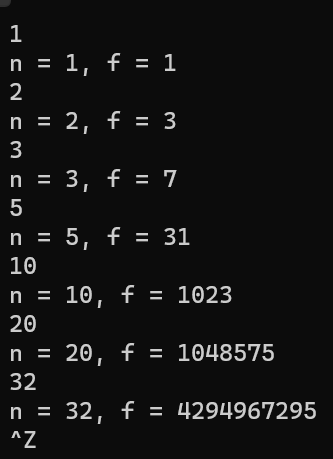
4、实验任务4
源代码
1 #include <stdio.h> 2 int func(int n, int m); 3 4 int main() { 5 int n, m; 6 7 while(scanf("%d%d", &n, &m) != EOF) 8 printf("n = %d, m = %d, ans = %d\n", n, m, func(n, m)); 9 10 return 0; 11 } 12 int func(int n,int m){ 13 int i,j; 14 int up=1,down=1; 15 for(i=0;i<=m-1;i++) 16 up*=n-i; 17 for(j=0;j<=m-1;j++) 18 down*=m-j; 19 return up/down; 20 }
运行结果截图
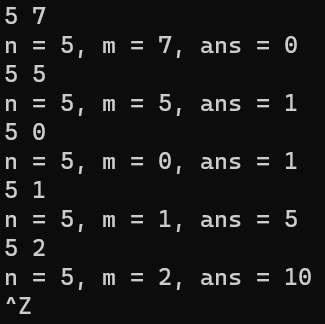
源代码
1 #include <stdio.h> 2 int func(int n, int m); 3 4 int main() { 5 int n, m; 6 7 while(scanf("%d%d", &n, &m) != EOF) 8 printf("n = %d, m = %d, ans = %d\n", n, m, func(n, m)); 9 10 return 0; 11 } 12 int func(int n,int m){ 13 if(n<m) 14 return 0; 15 if(n==0||m==n) 16 return 1; 17 else if(n==1) 18 return m; 19 else 20 return func(n-1,m)+func(n-1,m-1); 21 }
5、实验任务5
源代码
1 #include <stdio.h> 2 #include<stdlib.h> 3 void hanoi(unsigned int n,char from,char temp,char to);/*递归函数声明*/ 4 void moveplate(unsigned int n,char from,char to);/*移动函数的声明*/ 5 long long func(int n); 6 7 int main() { 8 unsigned int n; 9 while(scanf("%u",&n)!=EOF){/*输入盘子数目*/ 10 hanoi(n,'A','B','C'); 11 printf("一共移动了%lld次\n",func(n)); 12 } 13 system ("pause"); 14 return 0; 15 16 } 17 void hanoi(unsigned int n,char from,char temp,char to){ 18 int i=0; 19 i++; 20 if(n==1) 21 moveplate(n,from,to); 22 else 23 { 24 hanoi(n-1,from,to,temp); 25 moveplate(n,from,to); 26 hanoi(n-1,temp,from,to); 27 } 28 } 29 void moveplate(unsigned int n,char from,char to){ 30 int i; 31 printf("%u:%c-->%c\n",n,from,to); 32 } 33 long long func(int n){ 34 if(n==0) 35 return 0; 36 else 37 return (func(n-1)+1)*2-1; 38 }
运行结果截图
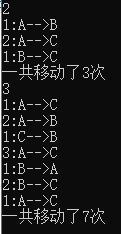
6、实验任务6
源代码
#include <stdio.h> #include <math.h> #define N 10000 long func(long s); // 函数声明 int main() { long s, t; printf("Enter a number: "); while (scanf("%ld", &s) != EOF) { t=func(s); printf("new number is: %ld\n\n", t); printf("Enter a number: "); } return 0; } long func(long s){ int length=0,k=0,m=0,t=0,j=1; k=s; while(s){ s=s/10; length++; } s=k; int i; for(i=1;i<=length;i++) { m=s%10; s=(s-m)/10; if(m%2!=0){ t+=m*j; j*=10; } else continue; } return t; }
运行结果截图
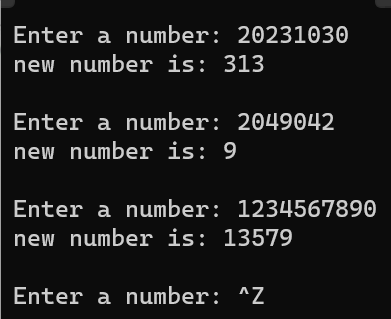
7、实验任务7
源代码
1 #include<stdio.h> 2 #include<stdlib.h> 3 4 int square(int n) ; 5 int cube(int n); 6 int bubble_sort(int a[]); 7 8 int main() 9 { 10 int n=1,sq,cu,a[10],i; 11 while(1){ 12 sq=square(n); 13 cu=cube(n); 14 i=0; 15 while(sq!=0){ 16 a[i]=sq%10; 17 sq=sq/10; 18 i++; 19 } 20 while(cu!=0){ 21 22 a[i]=cu%10; 23 cu=cu/10; 24 i++; 25 } 26 bubble_sort(a); 27 if(a[0]==0&&a[1]==1&&a[2]==2&&a[3]==3&&a[4]==4&&a[5]==5&&a[6]==6&&a[7]==7&&a[8]==8&&a[9]==9) 28 break; 29 n++; 30 } 31 printf("%d\n",n); 32 33 system("pause"); 34 return 0; 35 } 36 int square(int n){ 37 n=n*n; 38 return n; 39 } 40 int cube(int n){ 41 n=n*n*n; 42 return n; 43 } 44 int bubble_sort(int a[10]){ 45 int i,j,t; 46 for(i=0;i<9;i++) 47 for(j=0;j<9-i;j++) 48 if(a[j]>a[j+1]) 49 { 50 t=a[j]; 51 a[j]=a[j+1]; 52 a[j+1]=t; 53 } 54 }
运行结果截图
